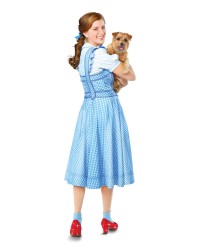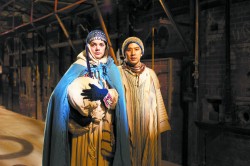 Just in time for the holidays, the North American premiere of The Wizard of Oz settles into the Ed Mirvish Theatre for an open-ended run on December 20th, replete with Dorothy, Toto and the cast of characters known the world over. An adaptation of the 1939 film that won Academy Awards for both Judy Garland and “Over the Rainbow” (the song by Harold Arlen that became the singer’s signature), the musical is the brainchild of Andrew Lloyd Webber, the celebrated producer/composer (The Phantom of the Opera, Sunset Boulevard) who opened the show at the London Palladium, which he owns and operates, in March 2011. The Toronto production, presented under the auspices of Mirvish Productions, uses the same creative team to duplicate the staging that won accolades for Robert Jones, the production’s designer whose collaboration with writer/director Jeremy Sams transformed the fantasy world of L. Frank Baum’s 1901 novel into a visual feast as distinctive as the one Victor Fleming committed to celluloid. Considering that the film’s special effects, to say nothing of the performances of its cast, have accrued mythic status while scaling the heights of cinematic and cultural history ever since, this is no minor achievement.
Just in time for the holidays, the North American premiere of The Wizard of Oz settles into the Ed Mirvish Theatre for an open-ended run on December 20th, replete with Dorothy, Toto and the cast of characters known the world over. An adaptation of the 1939 film that won Academy Awards for both Judy Garland and “Over the Rainbow” (the song by Harold Arlen that became the singer’s signature), the musical is the brainchild of Andrew Lloyd Webber, the celebrated producer/composer (The Phantom of the Opera, Sunset Boulevard) who opened the show at the London Palladium, which he owns and operates, in March 2011. The Toronto production, presented under the auspices of Mirvish Productions, uses the same creative team to duplicate the staging that won accolades for Robert Jones, the production’s designer whose collaboration with writer/director Jeremy Sams transformed the fantasy world of L. Frank Baum’s 1901 novel into a visual feast as distinctive as the one Victor Fleming committed to celluloid. Considering that the film’s special effects, to say nothing of the performances of its cast, have accrued mythic status while scaling the heights of cinematic and cultural history ever since, this is no minor achievement.
It probably was inevitable that Baum’s much-loved fable would find life in the theatre, but its success was by no means assured. This helps to explain why Lloyd Webber hedged his bets when he undertook the London production. Banking on the kudos garnered by Jones and Sams for their revival of The Sound of Music at the Palladium in 2006, he gave them full license to create a new vision of Oz; in addition, he supplied them with new material — primarily, songs he himself wrote to augment Arlen’s score.
Although the original songs are memorable, their lyrics by Yip Harburg illustrate that the movie is not a musical but, rather, a story with music — too fine a point to belabour here, but one that film historians emphasize, and Lloyd Webber shares. On record as considering the film score under-written, he invited Tim Rice, his first (and best?) collaborator (Jesus Christ Superstar, Evita), to write the lyrics for his new melodies. Rice accepted, thus ending a long-standing separation from his erstwhile partner while completing the new material which, in the tradition of contemporary musicals, is more character-driven than plot-inspired. This becomes evident quickly in the production when Dorothy sings “Nobody Understands Me,” a Rice/Webber number, in Scene One. “Over the Rainbow,” her first song in the film, must wait till Scene Two.
Caroline McGinn, theatre critic at London’s Time Out, opines that Webber and Rice are “right to add [the] extra material” for “the new music is tense and atmospheric, albeit a tad cruel and campy.” In The Guardian, Michael Billington concurs, suggesting that the additions are “perfectly acceptable” and citing, in particular, Dorothy’s “plaintive” opening song and the “pounding intensity” of the “Red Shoes Blues,” a new number for the Wicked Witch of the West. Nevertheless, he suggests that the additional material, in its pursuit of a nebulous “full-blown musical” form, disrupts “the delicate balance” between fantasy and music that the film attains, ultimately making “an essentially simple fable about the importance of individual worth seem overblown.”
At its core, The Wizard of Oz is about heart — or, more accurately, its absence. While the Tin Man can openly lament his physical emptiness, other characters must reveal their heartlessness in less literal ways — unless, of course, they are downright wicked. The unmasking of the Wizard near the conclusion of the piece brings to full poignancy Baum’s parable of dashed hopes and thwarted desire in which Dorothy’s quest for a return route to Kansas stands in for her search for love and acceptance, always out of reach. What better way to fulfill her longing, and that of all the Dorothys of the world, than to make her dreams come true?
Surely, this, as well as clever marketing, influenced Lloyd Webber’s decision to cast the role of Dorothy through a national audition masked as a television show. In the UK, over 10,000 women competed for the part which, in the end, was decided by the public through phone-in votes on Over the Rainbow, a BBC One musical rendition of reality TV. Building an audience for the stage production in what amounted to a long-running television commercial, Lloyd Webber repeated the formula that worked so successfully for The Sound of Music for which, to win the coveted role of Maria, neophyte actors auditioned on BBC TV’s How Do You Solve A Problem Like Maria? Although the premise of these shows is obviously commercial, the dreams that fuel their participants’ ambitions — and the support of their fans — are more real than Dorothy’s. Winning the competition equals getting a job. Appearing on a popular television show secures exposure and opportunity. When Elicia Mackenzie won the role of Maria in the CBC’s version of How Do You Solve in 2008, she launched a career that otherwise might have eluded her. “I will never forget the feeling of that moment when they called my name!” she acknowledges. And nor should she.
In Toronto’s Wizard, Danielle Wade plays Dorothy Gale after winning the part through an audition process identical to the one taped by the BBC. Here, CBC-TV cooperated with David Mirvish and his co-producers to create a reality show also called Over the Rainbow — adding further lustre to the template that Webber can market as a success. Joining Wade, a 20-year-old student at the University of Windsor, is an all-Canadian cast of veteran performers certain to make her onstage experience real — at least for her. Cedric Smith, a Gemini-winning film and theatre performer,stars as the Wizard. Lisa Horner, featured regularly at both the Shaw and Stratford Festivals, plays the Wicked Witch. Actor and choreographer Mike Jackson takes on the Tin Man. A Dora Award winner for his play High Life, Lee MacDougall plays the Lion. Jamie McKnight, one of the Canadian Tenors, breathes life into the Scarecrow. And Robin Evan Willis, well-known for many Shaw Festival productions, plays Glinda.
And heart? Does the show have heart? Well, dear reader, that is for you to decide. With certainty, I promise that the production will have spectacle. Discussing the Palladium show, Billington notes that, “Not since 19th century Drury Lane melodramas can London have seen anything quite like it.” With the same design team at work in Toronto, local audiences can anticipate a similar experience. “The Kansas cyclone that whisks Dorothy into a dreamworld is evoked through vorticist projections (the work of Jon Driscoll) that betoken chaos in the cosmos. The yellow brick road is on a tilted revolve from inside which poppyfields and a labyrinthine forest emerge. The Emerald City is full of steeply inclined walls suggesting a drunkard’s vision of the Chrysler Building lobby. And the Wicked Witch of the West inhabits a rotating dungeon that might be a Piranesi nightmare.” Not exactly suitable for young children? Well, neither is the movie.
Snow White: If you’re looking for “family fare” of a less scary sort, albeit with less innovative staging, check out Snow White, a presentation by Ross Petty Productions that opened at the Elgin theatre on November 23 and runs through early January. The latest in a series of shows presented by this unique company every Christmas, Snow White follows the conventions of British pantomime that the London Palladium was built to present in the early 20th century. Almost always, pantomime is based on traditional children’s stories, especially fairy tales (Cinderella, Aladdin, Peter Pan etc.), performed at Christmas for family audiences. Interestingly, although The Wizard of Oz figures rarely as the subject of pantomime, Ross Petty used it here only last year to create his annual Elgin panto in which a skateboarding Dorothy was deposited in a place called Oz where, as John Bemrose put it in the National Post, “a gyrating gesticulating crew of outback yokels, whom the Wicked Witch of the West dismisses, not too unjustly, as a bunch of ethnic stereotypes” are quickly recognized as Aussies. (It’s worth noting in this context that in last year’s Petty pantomime production of Oz at the Elgin, Dorothy was played by Elicia Mackenzie, and that, by falling in love with the Tin Man, performed by Yvan Pedneault, a formidable talent that Mirvish introduced to local audiences in We Will Rock You, she helped him find his heart.)
British pantomime (or “panto” as it is affectionately termed “over there”), has been popular since the mid-19th century, its use of song, dance, buffoonery, slapstick, crossdressing, in-jokes, topical references and audience participation appealing to people of all ages. Indeed, theatrically spectacular musicals such as the Webber Oz and pantomime share similar goals — notably, reassurance of the audience’s values (hence the use of stock characters and well-known stories) coupled with emotional and visual transport.
Variations to the story of Snow White in this year’s panto, while equally audacious, are more traditionally conceived to adhere to the conventions of the form. Subtitled “A Deliciously Dopey Family Musical!” the show collapses the seven dwarfs of the original fairy tale into one character — 007, a James Bond lookalike played by Stratford leading man, Graham Abbey, whose appearance fulfills the convention of a celebrity guest star. As usual, the convention of the crossdressed older woman (known as the “pantomime dame”) is addressed by Petty himself who, by performing the role of the evil Queen, adds another drag performance to the long list of comic portrayals that makes him a fan favourite. Playing the title character is Canadian Idol winner Melissa O’Neil who made her panto debut as Belle in Petty’s 2010 production of Beauty and the Beast. Fresh from appearing in the Broadway production of Stratford’s Jesus Christ Superstar, she perpetuates an unofficial connection between Petty and Mirvish that the work of Andrew Lloyd Webber continues to facilitate.
 The Story: Moving further afield, geographically if not aesthetically, a third show provides a unique form of spectacle even as it depicts a narrative traditional to the season. The Story, a production by Theatre Columbus, conceived and written by Martha Ross, returns to the Evergreen Brick Works on December 4th where it plays for the remainder of the month. Now in its 29th year, Theatre Columbus has a prestigious history of innovative play creation and production, with roots firmly planted in the creative compost of clown, commedia and buffoon. Ross, a co-founder of the company, unites her performance experience and writing skills to create the script for The Story which uses various locations in the Brick Works and its adjacent parkland to imbue the tale of the nativity with comic irreverence and visual beauty.
The Story: Moving further afield, geographically if not aesthetically, a third show provides a unique form of spectacle even as it depicts a narrative traditional to the season. The Story, a production by Theatre Columbus, conceived and written by Martha Ross, returns to the Evergreen Brick Works on December 4th where it plays for the remainder of the month. Now in its 29th year, Theatre Columbus has a prestigious history of innovative play creation and production, with roots firmly planted in the creative compost of clown, commedia and buffoon. Ross, a co-founder of the company, unites her performance experience and writing skills to create the script for The Story which uses various locations in the Brick Works and its adjacent parkland to imbue the tale of the nativity with comic irreverence and visual beauty.
Based on the gospels of Matthew and Luke, the events of The Story are widely known. In this hour-long version, they occur mainly outdoors as the audience follows the flickering lantern of a solitary shepherd as he guides them past kilns, under iron girders, along gravel paths, through various interiors and into open spaces. With a strong eye for visual composition, director Jennifer Brewin uses the industrial and natural geography to imaginative effect, ably supported by Catherine Hahn (set and costumes), Glenn Davidson (lighting) and John Millard who, as sound and musical director for the production, oversees the local choirs (a different one each evening) that serenade the audience with seasonal songs while it weaves its way to each location.
Brewin’s DORA award for her direction of the premiere of this show last year is well deserved. Her decision to bring a physical approach to the material encourages the actors to develop their characters with broad, clown-like techniques at which they excel. The Three Kings are lost and disoriented; Mary is impatient and tense; King Herod is paranoid and petulant; and Gabriel, the herald, overwhelmed by the message he must deliver, has a dizzy quality reminiscent of a befuddled fairy in a panto. In fact, all the characters resemble those of a pantomime, their slapstick and buffoonery foregrounding psychological states and, ultimately, infusing their situation with a winning humanity.
The Story is short, sweet, and, at times, stunningly beautiful—the majesty of a star-lit winter sky providing a backdrop so unexpected that it hardly seems real. But it is, and so is the weather. Dress warmly and treat yourself to the hot chocolate on sale at the site — unusual directions for my hot tip of the month.
Based in Toronto, Robert Wallace writes about theatre and performance. He can be contacted at musictheatre@thewholenote.com.



